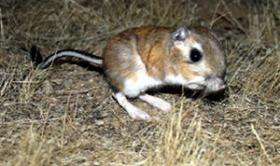Scientists explore hormone evolution

(PhysOrg.com) -- New research techniques on animals living in the wild are helping scientists test long-held ideas about the role of hormones in survival, according to comments by Professor of Biology Jan Randall at the recent American Association for the Advancement of Science annual meeting.
Randall described recent developments in non-invasive techniques such as tracking mammals to gather feces, and sensitive tests that allow researchers to examine hormones in feces to formulate a more complete picture of the relationships among behavior, social systems and hormone function in mammals in the wild. "Previously, much of the information we have on hormones came from limited sets of models like lab rats and mice," Randall said. "This non-invasive method is allowing us to ask evolutionary, physiological questions about animals in the wild in completely new ways."
While most of the recent field research has been conducted on rodents, researchers are beginning to conduct field work with whales, predatory animals and other mammals. Randall said it's important to challenge findings discovered in a lab setting. "We see species specific adaptation of control systems so we must rethink our evolutionary models of hormones," she said. "As we discover more in the field, we may discover many more unusual adaptations important for reproduction and survival."
When Randall began post-doc work in the late 1970s, research was confined to drawing hormones from blood or from trapping animals in the wild. Often, those methods yielded hormone samples that were tainted by heightened stress hormones when the animals were handled by researchers. If researchers can identify which specific animal produced feces in the wild, it's possible to gain a better understanding of the effects of social stress and survival. "We need a specific sample and a social context to know what's going on hormonally," Randall said.
To study stress in natural populations, Randall collected feces from the great gerbil, Rhombomys opimus, in Uzbekistan over the course of six years, and the giant kangaroo rat, Dipodomys ingens, in California. The great gerbils are highly social rodents who live in high density communities. Some male gerbils would live with up to six females and their offspring. Randall wanted to know whether the social stress was affecting the male's ability to survive. For six years, Randall and her collaborators collected feces from specific males at various times throughout the year and found that males were stressed in large family groups but that outside factors like drought had a greater influence on survival than stress.
Randall and her graduate student, Julia Barfield, collected fecal samples during the breeding and non-breeding cycles of the giant kangaroo rat. They found significantly higher levels of testosterone in the summer non-breeding season than in the breeding season in both male and female kangaroo rats, which counters previous research conducted in a laboratory setting. Randall said the finding illustrates the flexibility of hormonal control systems and the importance of exploring them in wild populations.
Provided by San Francisco State University





















